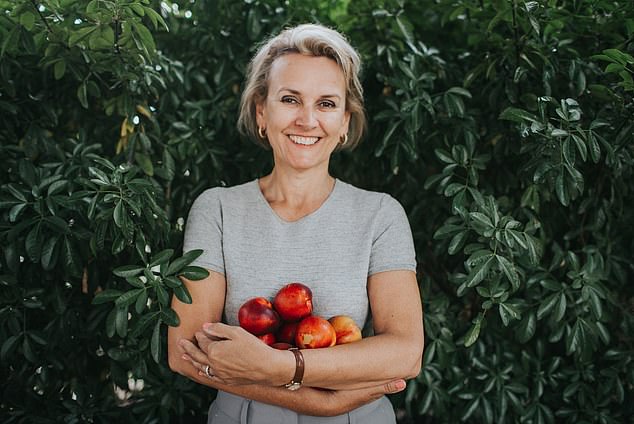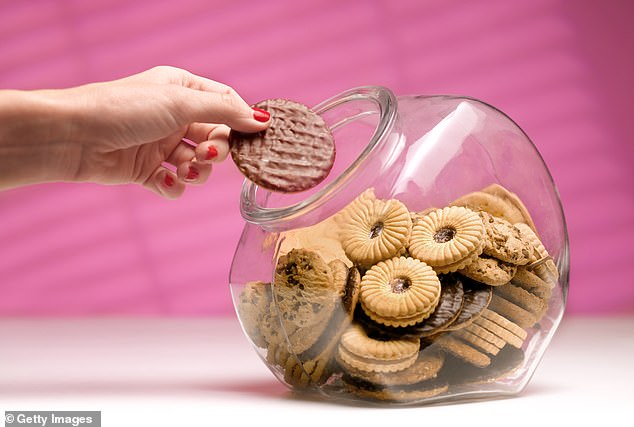I used to think about food most in the evening. I’d graze and snack, and then regret it. The part of the nation’s current obsession with weight-loss jabs that I relate to most is the way they eradicate the ‘food noise’ that would drive me to the fridge and the ice cream tub.
But I also knew, as a psychologist, there must be another way of dealing with food noise and the cravings that come with it. And indeed, there is. I am proof of it.
Over six months I altered my insistent appetite completely, retraining it with no drugs required. And I only had to do it once to lose all the weight I wanted. It’s a method I’ve since discovered works for a lot of people, without altering your appetite signals with fat jabs – although those who are living with obesity have benefited hugely from the emergence of weight-loss drugs.
Like so many women, my weight issues began after my first pregnancy. At 38 I weighed 11st 5lbs – about a stone and a half more than I wanted to be – and so I joined WeightWatchers. After three and a half months, I’d lost it and now weighed 9st 11lbs.
But it required a hellish amount of self-restraint, and I became obsessed with when the next mouthful of food was coming. It wasn’t a regime I could sustain and within six months of reaching my target weight, I put most of it back on, settling at 10st 9lbs – at the top of the healthy weight range for my height of 5ft 5in.
For the next 15 years, my weight became an annoying issue, lingering in the background.
By the summer of 2011, I’d been working as a clinical psychologist for two decades and was treating a woman in her forties who’d developed bulimia, triggered by a very low-calorie meal-replacement plan. She made an excellent recovery but in her last session told me ‘I just wish I could lose a stone’.
I’d helped her overcome a serious eating disorder, but I had no idea how to help her lose weight because I still hadn’t lost my own. It was a turning point. I knew there must be a way of applying psychological methods to sustainable weight loss.

Dr Helen McCarthy, the Appetite Doctor, who retrained her brain to shut down food noise
I broke down the problem, starting with why I was overweight, then the steps I’d take to make losing it manageable. I analysed my eating patterns, noticing I was scared of getting hungry and would eat to prevent it. I was also opportunistic – I’d eat because food was there.
One by one I began to tackle my issues, relearning how to use appetite signals to guide my eating – and sure enough, the weight dropped off. It took six months to get to 9st 2lbs, but I only had to do it once and I have kept the weight off ever since. Here’s how you can too.
What are your bad habits?
There’s a long list of reasons why women are heavier than they want to be, and you need to identify yours. It might be an erratic eating routine, skipping meals to save calories or eating too much unhealthy food.
For me, it was that my meals were larger than I needed, and I would eat when I wasn’t hungry. I’d eat beyond the point of being full and not even notice. My dinner would be the same size as my husband’s: three sausages and what I thought was a medium portion of mash, plus vegetables and gravy. Then I’d still be looking for snacks in the evening.
I noticed I was anxious about even the possibility of being hungry. This led to an absurd practice of ‘insurance policy eating’, where I might buy chocolate to prevent getting hungry on the train, for example, but then eat it whether I was hungry or not. I would also eat in the evenings because I was tired, bored or wired from the day. I’d graze on chocolate and crisps, none of it enjoyable or satisfying.
Through trial and error, I discovered the amount of food I needed to feel just full, which also meant I was genuinely hungry by the next meal.
Enjoy feeling hungry
Initially I found this incredibly hard, and it created a lot of anxiety.
I experimented with simple behaviour exercises like not buying the snack before starting my commute home. It’s about holding your nerve when everything is screaming at you to eat or put more food on your plate.
But if you do something repeatedly, you create the new habit. You have to face the natural discomfort that comes from making any change to your routine – and keep doing it. According to research, the average number of times you need to practise a new habit before it becomes default behaviour is 66. Patterns that you keep repeating (not buying the chocolate bar) become your beliefs (I don’t need the chocolate bar).
In time, I found that hunger became an ally and almost pleasurable. Our taste perception is heightened as we get hungrier; it’s much sharper. When you learn that, it’s life-enhancing.
But our appetite signals don’t all work in the same way. If you always feel unsatisfied at the end of a meal while everyone else is perfectly full, it’s not because of your failure to tune into your body’s natural signals, it’s that those signals work differently to theirs.
Record the times you eat and notice how you feel as the hours pass since your last meal or snack. Start the moment you’ve finished a meal – do you feel ‘just full’ or fully satisfied?
Then try to remain tuned in to whether you feel genuine hunger between meals or if what you are feeling is actually more about liking the idea of eating something.
Once I decided to see how long it would take me to get hungry after having an adult portion of fish and chips. I ate it on Sunday lunchtime, and I wasn’t hungry again until 2pm the following day.
I’d been eating so much unnecessary food. I was astonished at how little food I needed to keep me going between meals.
But the rewards outweighed the pain. The smaller amounts I was eating tasted better, and I had much more energy.
Stop eating when you’re full
I eat about a quarter of the food I used to, but it took trial and error to get to this point. It would be a terrible mistake for people to reduce their meal size by three-quarters overnight.
Start by reducing it by a quarter at the most and then get used to that new three-quarter size and see how you feel. Stick with this meal size until it’s the norm for you. Then you can reduce it by another quarter and so on.
I created a tool called The Appetite Pendulum which works on a moving scale from -5, which is extremely hungry, to +5, uncomfortably full. I suggest people get to -3 (definitely hungry) before eating and they aim to stop eating when they get to +3, just full. You’ll need one or two weeks to master where your feelings are on the pendulum.
I have retrained my appetite so I only eat a small plate of food at each meal. I’m now 65, with a very sedentary job, which may be why this small amount keeps me going. If I’m in a restaurant, I’ll order a starter and a dessert rather than a full meal (or two sides and a dessert) because I’ve got a very sweet tooth.

‘I have retrained my appetite so I only eat a small plate of food at each meal. I’m now 65, with a very sedentary job, which may be why this small amount keeps me going’
Try this handy trick
The idea is to shift your attention from one thing to the other – from the one you feel like doing (eat the cake) to the one you intend to do (stick to my goals).
The point is, we may have a rational intention, but we also have a drive to do something else.
The trick is to open and close each hand ten times while shifting your attention between the two options, saying them silently to yourself. When your brain processes unresolved information like this, it leans in the direction of what is adaptive and helpful, in this case sticking to your goals. It’s called the two hand interweave technique and people find it incredibly helpful because it can be done discreetly under the table.
Help your brain forget food
I love chocolate biscuits, but science has taught us that if we can see them, we are far more likely to eat them. So, I simply put less tempting food out.
If you have a food craving, make an active decision to place something else that’s not food related, such as a forthcoming event, into your working memory. Every time you think of chocolate biscuits, think instead of the party you’re going to at the weekend. This is the part of the brain that processes what is happening right now and anything new we need to learn, as opposed to the long-term memory that deals with established habit patterns.

Start by reducing it by a quarter at the most and then get used to that new three-quarter size and see how you feel
Don’t finish what’s on your plate
Most of us have been raised to believe you should clear your plate or you’re being wasteful, but it leads to people eating food they don’t need and never learning the amount that will keep them full. Once you’ve cut back your portion size you can clear your plate in good faith – but till then, stop eating it all.
Yes, it can be socially awkward when you’re eating at a friend’s house and in this case it’s worth remembering one large meal does not make you gain weight any more than one tiny meal makes you lose weight.
Remind your brain you’ve had enough
If I finish eating before my family, which is likely as my portions are smaller, I move away from the table, to reduce the risk of serving myself more food.
Or if that feels too rude or impractical, I place a glass of water between me and my plate. It acts as a reminder to the brain that you’re no longer eating. When the autopilot brain wants to reach for more food, there’s something in the way. There is also plenty of evidence that just slowing down the speed at which you eat reduces the amount you eat overall. Twenty minutes is a rough guide for how long it takes your brain to register that you’re full. So slow down, you can eat an awful lot of food in that time.
The last mouthfuls are the least tasty
We have a learned understanding that the end of eating something savoury activates the desire in your brain for something sweet. But there’s no physiological reason for this.
If you offered guests more main course, they might well turn it down, but still enthusiastically accept dessert. That is called ‘taste specific satiety’ and it demonstrates how our ability to taste a food reduces mouthful by mouthful.
It’s one of the reasons why reducing your meal size is less painful than you think it’s going to be – because the last quarter of that meal is the least tasty part.
Yet if you’re presented with a different sort of food, it’s like your whole appetite has been refreshed. If you can tolerate having a smaller main course, then you will still be able to have a small dessert too without taking yourself beyond feeling ‘just full’.

One of my non-negotiables when I started this plan was that I wouldn’t give up any food I liked, and for me that was sweet treats
Eat the things you love
One of my non-negotiables when I started this plan was that I wouldn’t give up any food I liked, and for me that was sweet treats. What enabled me to lose a stone and a half and keep it off was I’d have my small evening meal and then at about 9pm I would have a full-sized Magnum ice cream, at 250 calories, if I wanted it.
We would always eat with the children at 6pm so I was usually hungry for it. It meant there was always one planned treat I was looking forward to instead of endless evening snacking. For you the treat might be a glass of wine or a milky coffee. But it must feel special and not make you feel too full. Interestingly, over time the Magnum habit died out, without me intending it to.
Use heavy crockery and cutlery
Research shows if you eat yoghurt out of a heavy bowl, you perceive it as richer and better quality than if you eat it out of a light plastic bowl. That experience also makes us feel fuller quicker.
It’s a discipline called neurogastronomy and it also shows that the weight of the knives and forks we use influences our enjoyment of a dish. The heavier they are, the better the food is judged to be. So get the best stuff out for every meal.
And if all else fails, give menthol mouthwash a try. Studies show that menthol mouthwash after you’ve eaten makes you less likely to eat again soon.
As told to Jade Beer
Dr Helen McCarthy’s ‘How to Retrain your Appetite: Lose weight permanently eating all your favourite foods’ (Pavilion Books) is out now.
